Click Here if you listened. We’re trying to gauge interest so only one question is required; however, there is a spot for feedback!
Read along below!
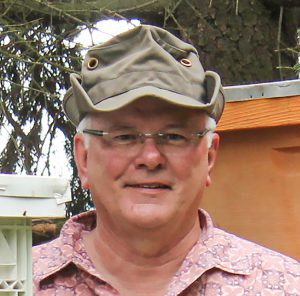 Beeyards Come and Beeyards Go
Beeyards Come and Beeyards Go
An apiary location is just for the moment
By: James E. Tew
An unusual topic
A strange topic this article has – Beeyards that I no longer have. Old, abandoned beeyards have played a major part in my personal beekeeping history and development. They are like long departed friends. Many of you have your old beeyard memories, too. I’m not special in this regard.
As the years have passed, I have steadily cut both the number of hives I manage and the number of yards I keep my bees in. Throughout my career, I estimate that I have had – at one time or another – about 45-60 permanent bee locations. At my peak, I (with help) maintained about sixteen different locations. Now, I have reduced my yards to only two apiaries, both reasonably near me. Yep, that’s quite a change for me.
My emotional attachment to some of these phased-out yards has surprised me. They have names that are totally meaningless to you, but they have been part of my life for years; the Metz yard, the Shreve yard, the Chipley yard, the County Home yard, Matt’s yard and the Fredericksburg yard are some of the many names of places that have now reverted to non-bee areas.
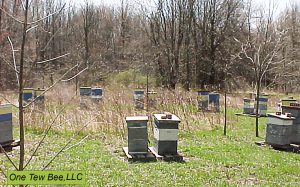
Figure 1. The Metz yard, twenty-five years ago
Specifically, the Metz yard and the Fredericksburg yard were locations that I personally established as a brand-new entomology professor at OSU in 1978. It seems impossible that I had some of these locations for 40+ consecutive years only to close them out. As a young man, I guess I just assumed that these yards would somehow continue forever.
In the case of the Metz yard, it was located off Metz Road, right here in Wooster, Ohio. At that location, through the years, I survived stuck trucks, swarms, American foulbrood, tall grass, the introduction of mites and ground hogs, but on the positive side we made a lot of honey there. Being located near a stand of pines, I, and my help, would gather bags of pine needles for our smoker fuel needs. At the time, it was a major part of my beekeeping psyche.
We were there so long that many years ago, the Senior Mr. Metz died requiring us to get permission from Mr. Metz’s surviving son to continue the use of the yard. He allowed us to stay so I passed into my second generation at this location. Then after decades of use, I finally gave it up, too.
Where is this reminiscing going?
Eliminating these yards made me realize that I have evacuated far, far more yards than I will ever again maintain. Yet each of those now abandoned locations was, for a while, a part of my beekeeping life. Stories and bee events came and went. Now nothing of a bee nature remains at these locations. In fact, there are only a very few people who could even remember the hives were ever there. That’s okay. It’s only important to me anyway.
Memories of some of my long-gone yards
Not all the memories that follow are specifically my yards, but they all contribute to my beekeeping memories. Here are some examples.
The Unit-Two Yard
The reason for the clumsy yard name is unimportant, but the now long-beeless yard has several significant memories for me. It was in this yard that I had the very personal experience of having a mouse run up inside my pant leg as I was removing supers from a hive. I have relived the story literally hundreds of times at meetings across the country, and I choose not to relive it again here, but you can believe that I will NEVER forget the experience I had in that yard (and neither will the mouse).
Reason for giving up the Unit-Two yard. Pesticides. The yard was located near university field plots and every year, the hives located there were seriously damaged by pesticide kills. I now wonder, in light of decreased pesticide use, if that yard could be reoccupied.
The Eck Yard
Mr. Clarence Eck was the grand old beekeeper in Wooster for many years. He was keeping bees long before I moved here. Mr. Eck is no longer with us, but he and others, including Jim Thompson, a frequent contributor to Bee Culture and longtime beekeeping friend, initiated a small beekeeping workshop for helping new beekeepers. This past March, the 44th annual version of this workshop, with hundreds of people in attendance, was conducted. Mr. Eck’s home beeyard, and one in which he conducted early beekeeping classes, was north of Wooster. That yard, too, is now gone.
Reasons for Mr. Eck giving up this apiary site. Concerns from the local Ford Motor Company dealership was the reason for abandoning the yard. The newly located dealership could not figure out where all the “birds” were coming from that defecated on their fine, new cars. It took them a while to figure out that it was neighboring bees – not birds – causing the issue, but when they did discover that it was bee poop on all their cars, under threat of lawsuit, a historical bee location was forced into oblivion.
The Sawmill Yard
In fact, the sawmill and the beeyard are now both gone. About thirty-eight years ago, I wrote a series of articles for the old Gleanings in Bee Culture under the mast head, The Solitary Beekeeper, from experiences I had in this yard. It was from this apiary, that I took a good friend to the hospital emergency room after he had a systemic reaction to multiple bee stings. His tongue was swollen and had become bluish. He recovered in good order, but he won’t ever forget this bee place. Neither will I.
This yard was located on the property of a large, creepy, abandoned state mental hospital. While moving beehives past midnight one dark, quiet night, I inexplicably became spooked – one of those sixth sense things. I couldn’t talk myself out of the threatening feeling. I unhooked the bee trailer from the truck and left some of the hives open and in disarray. When I returned the next day – nothing. No Big Foot – no monsters – no nothing. I recently did a podcast describing this recollection. Now, nothing remains there but memories.
Reasons for giving up the Sawmill Yard. American foulbrood outbreaks and agricultural encroachment. The yard is now a soybean field and the sawmill building is standing derelict.
The Chipley Yard
During the early ‘80s, I kept a yard of about 80 hives of Ohio State (OSU) hives in Chipley, Florida. At the time, I had a thriving international beekeeping program made up of people who wanted to learn more about migratory beekeeping. I wintered OSU bees in Florida and produced Springtime queens there.
I have many, many memories of driving trucks to Florida, loaded with palletized beehives, dead tired, stressed, but being a real migratory beekeeper. It was a spectacular amount of work. No one got hurt. We kept good bees and we all had a good experience. To this day, this yard makes up the bulk of my migratory beekeeping experience. I have a life-long collection of memories of “stuck trucks and late nights” from this yard. As usual, I wrote about my experiences.
Reasons for giving up the Chipley Yard. Bee program redirection, transportation costs and mud (accessibility). I understand that watermelons are now planted where our beeyard was once located.
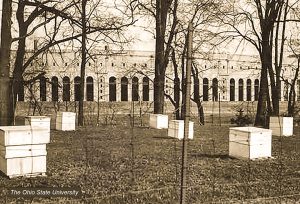
Figure 2. The Ohio State University football stadium, circa 1940s. There are no bees there today. This photo shows how much society has changed.
Multiple Ohio State University Beeyards
I don’t even know how to review all the Ohio State University honey bee program yards that have come and gone. One of the most famous was beside the football stadium. If I put bees that near the stadium today, people would freak but in the 1940’s, it was fine.
The first beeyard here in Wooster at the OSU Research Center where I worked is now a parking lot that I frequently drive past. While looking at several hundred cars in that parking lot, who would ever believe that it was once a grassy beeyard?
Reasons for giving up these various Ohio State yards. Civilization encroachment in nearly every case.
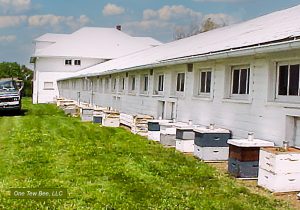
Figure 3. The Bee Barn and Beeyard in 2002.
The Bee Barn
In an earlier life, the Bee Barn was a university swine facility, and then a turkey facility. Then in its later life, and after a thorough steam cleaning, it became the Bee Barn. It had everything – even a restroom and was partially heated. It was absolutely filled with eighty years of beekeeping equipment and supplies. In 2010, a tornado utterly destroyed it – completely. Today, nothing remains of the bee barn, the beeyard or any of the equipment that it stored. It’s an open, grassy field. Nothing but memories remain.
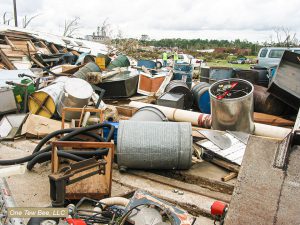
Figure 4. The Bee Barn and Yard after the 2010 tornado. Today, nothing remains but an open field.
Reason for abandoning the yard was complete destruction of the facility and the hives.
My oldest remaining yard
I have kept bees at the back of my home property for forty consecutive years. One of the primary reasons that I moved north of town was to be able to keep bees on my property. From that apiary, I have produced multiple videos, written tens and tens of articles, made several thousand photos and produced podcasts. I have sat in that yard, watching my bees, for thousands of hours. It was my haven during the covid pandemic. It was my private, quiet place.
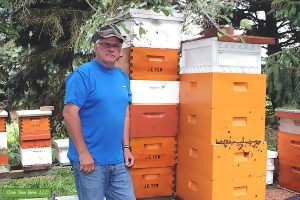
Figure 5. Jim Tew, with some of his bees in his home yard that will have to be relocated.
Now, as I have written before, within twenty feet of my colonies, a new housing subdivision with multiple housing units is being built this Summer. Heretofore, the area behind me was a soybean field. The access road to the division will be hardly ten feet from my some of my current bee hives. It does not matter that I was here long before the housing project. I will surely get complaints from construction people and subsequent home owners.
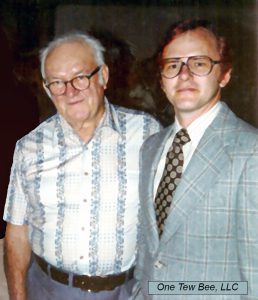
Figure 6. C. Eck and Jim Tew forty years ago (1982)
Do you recall Mr. Eck, the Wooster beekeeper, who I wrote about earlier in this piece? He had a beeyard behind his house, too – just like me but even closer to his home. The City of Wooster built a grade school on the property that joined the rear of his house.
For years, Mr. Eck, the bees and the school kids lived together agreeably. Only a wire fence separated them. Quite a while ago, Mr. Eck passed and his bees were sold. Then, recently, the school was permanently closed. A Caribou Coffee Shop stands on the location now. In this case, everything is gone – the beekeeper, the bees, even the school, but for many years, that was a hive hot-spot. I cherish the memories.
But times have changed. Now, I don’t think I can have bees so near new homes that could possibly have children – especially curious ones who go exploring. So, yes… I am making plans to move my colonies until the construction phase passes. Apparently, in my life, no beeyard location is sacred.
But again, times have changed. I am now much older. In the past, I kept 20+ colonies in my back yard – far more than I should have. But I lucked out and nothing ever happened. I no longer want nearly that many colonies there. Maybe… just maybe, I can put two to three colonies there again. I have some fencing up already and I will install even more.
So, the beekeeping humor here is that, due to aging, and passing time, I have reduced my apiary locations to only two sites. Of the remaining two locations that I now have, one is having a housing property built nearby and the other is apparently home to a roving bear that destroyed one of my colonies this past year. Readers, presently, I have zero good locations. Beeyards are weird like that. Good for a while and then not good.
Here’s the truth
If you have hung on to this point, you must have figured out that I am writing this piece for me as much as for you. I must have several hundred slides, digital photos and videos of various beekeeping events in yards that are now beeless. Most of these pictures recall good memories of bee times past.
Though not the only reason, but a primary reason for me evacuating most of the yards that I have deserted was some kind of encroachment—not just urbanization. In some instances, farmers wanted their land to put back into cultivation. For example, watermelons in Chipley and soybeans in Ohio. The Ford dealer causing Mr. Eck’s yard to be move is an instance of commercial encroachment. I am now experiencing housing encroachment.
Secondly, a common reason for giving up yards was accessibility – mainly mud and narrow gates – that would trap my bee trucks. Here’s the oddity. I have never once left a yard because of a lack of bee food sources or limited water supply or a damaging frost pocket or because my hives couldn’t be faced to the east or some such. I left all these locations because of encroachment, mud and in a single case – pesticides. It doesn’t help that I am aging. I gave up some locations for that reason. When I pass by these abandoned apiary sites, I usually have a look and think, “I used to have bees there.”
A beeyard is a bit like the circus coming to town. Lots of planning, preparation, activity and work, only then to be gone. All that remains is memories of the circus. Some yards last much longer than others, but sooner or later all beeyards give it up only to become memories for unique people like you and me.
You just wait
If you keep bees long enough, you will get your own “abandoned yard” memories, too. But shake them off. No doubt, right now you should be out in your present yard doing bee stuff. Let the future take care of itself. Thank you for reading.
Dr. James E. Tew
Emeritus Faculty, Entomology
The Ohio State University
tewbee2@gmail.com
Co-Host, Honey Bee
Obscura Podcast
www.honeybeeobscura.com








